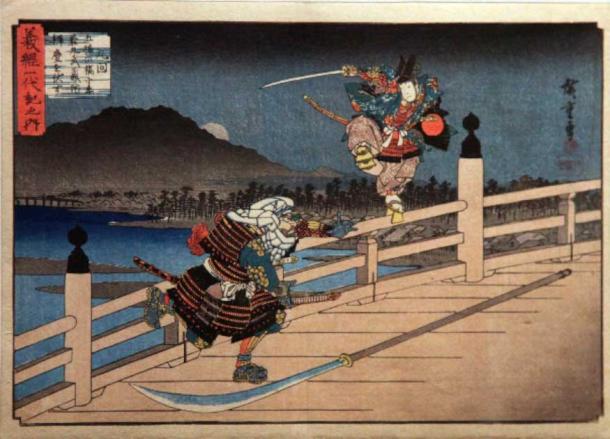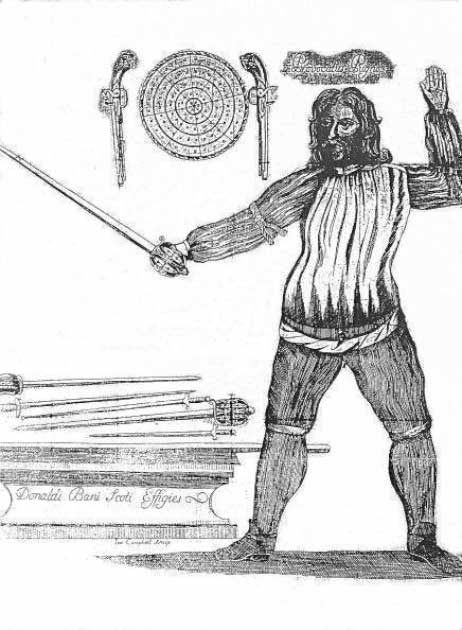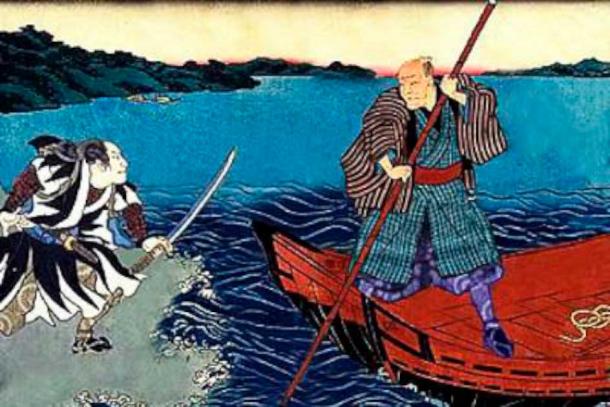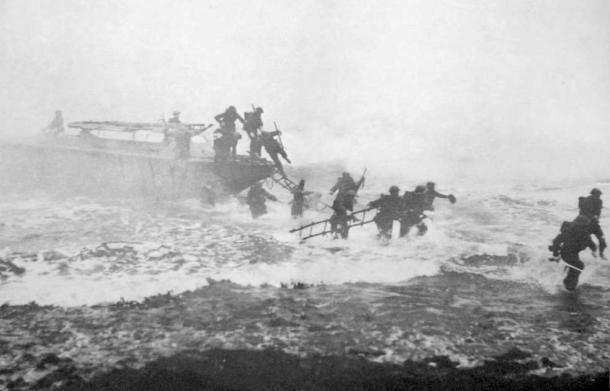
7 of The Most Skilled Sword Fighters in History
Besides perhaps the gun, no other weapon has been as heavily romanticized as the sword. For millennia, we’ve been using the sword to settle debates, both personal quarrels in the form of duels, and national conflicts in the form of wars. But the truth, is the use of the sword in warfare has been oversold to us. The sword has a high skill ceiling, limited range, and limited versatility in a combat setting. Much of the time, it only served as a secondary weapon. Yet one thing remains true: when it comes down to the rule of cool, the sword still reigns supreme. History is full of tales of legendary swordsmen who mastered this difficult martial art. Here are seven of history’s greatest swordsmen.
1.Minamoto Yoshitsune: The Quintessential Samurai
Thanks to the popularity of Japanese samurai films, anime, and western films like Quentin Tarantino’s Kill Bill, when we think of master swordsmen, we often think of samurai. This is for good reason. Some of the best swordsmen to have ever lived came from Japan.
One of the most famous is Minamoto Yoshitsune, a skilled sword fighter and master strategist. Yoshitsune was the son of Minamoto Yoshitomo, the leader of the powerful Minamoto Samurai clan in 12th century Japan. While Yoshitomo was killed by the rival Taira clan, during the Heiji rebellion of 1160, several of his sons, including Yoshitsune were spared.
From an early age, Yoshitsune was obsessed with learning. He was raised in a monastery and devoured works, such as Sun Tzu’s legendary Art of War. He was trained in the art of sword combat and soon became proficient. As a young man, he left the monastery to travel, perfecting his chosen art by dueling anyone foolish enough to challenge him.
One of these men was the legendary warrior monk, Benkei. Benkei was said to be 6 foot 7 inches (200 centimeters) tall, with the attributes of a demon. It is said he killed 200 people in every battle he entered. After his defeat at the hands of Yoshitsune, he became the samurai’s right-hand man.
Yoshitsune later became a general of his clan, and with his brother, Minamoto Yorimoto, went on to wipe out much of the Taira clan and establish Japan’s first shogunate. The two brothers later fell out, leading to Yoshitsune’s betrayal at the hands of his brother.
What happened after this is unknown. Yoshitsune’s end is shrouded in legend. Some say he left Japan to live with a foreign lover; others say he went on to become Genghis Khan. A popular story states he committed seppuku, Japanese ritual suicide, while his fierce companion, Benkei guarded him. The giant is said to have stood on a bridge, protecting his master. He supposedly took out over 300 warriors until he was finally felled by an arrow. He died standing in what is called the “standing death of Benkei”.
- Samurai Secrets Revealed: English Translation of the 500-year-old ‘Sword Scroll’ Provides Fighting Tactics Including ‘Egg Them’
- Women Scrapping with Swords and Pistols: Famous Female Duels

Fight between legendary sword fighters Yoshitsune and Benkei at Gojo Bridge near Kyoto, drawing circa 1834 (Public Domain)
2.Fiore Dei Liberi: The Medieval Fencing Master
Of course, Europe has produced its fair share of great sword fighters. Fiore Dei Liberi, the author of Flower of Battle, is remembered as one of the best swordsmen and fencing masters that medieval Europe ever produced.
Today, little about Liberi is known for sure. We know that he was born around 1350 AD, and was most likely born in a small Italian town called Premariacco. He was the son of a local lord, and his life of relative luxury meant he had plenty of time to practice his fencing, learning under many of the German and Italian masters of the Holy Roman Empire.
After Liberi had been practicing for half a century, he wrote Flower of Battle, one of the oldest surviving fencing manuals in existence. The book is still widely studied by modern fencing practitioners and martial arts aficionados.
Liberi wasn’t just a writer, however. He taught the art of fencing to many of the royal houses in his surrounding area. His reputation as one of sword fighting’s greats comes from his many duels. He is particularly famous for the five duels he fought against the best fencing masters of the time.
- Roman Weapons: Sharp Blades to Conquer the Ancient World
- 10 Innovative Medieval Weapons: You Would Not Want To Be At The Sharp End Of These!

A page from a 15th century copy of Liberi’s famed Flower of Battle. His manual continues to be used by sword fighters even today! (Public Domain)
3.Donald McBane: The Scottish Brute
Some master sword fighters lived a devout existence, dedicating themselves completely to the study and mastery of their art. Others, like Donald McBane, just loved a good fight.
Donald McBane is believed to have been born in Inverness in Scotland in 1664. Today, he is remembered as one of Europe’s best sword fighters, but it wasn’t always so. In fact, for a master swordsman, he got off to a pretty rough start. McBane’s early military history involves a lot of fleeing from battles, especially during clan conflicts. His career as a sword fighter didn’t start until he got into a heated argument with one of his senior officers during the Nine Years’ War. The altercation taught him that if he was going to survive army life, he needed to teach himself to fight.
McBane had a hot temper and his fighting style reflected this. It was powerful and assertive, forcing his enemy into submission. His most famous move, “The Boar’s Thrust,” involved dropping to one knee and thrusting his sword upwards in a powerful uppercut blow.
After making a name for himself as a fencer, McBane moved to Ireland, where he opened his fencing school and solidified his school’s reputation by beating the masters of four rival schools. Amazingly, McBane’s school wasn’t just a place for learning sword fighting; it also served as a brothel!
McBane claimed to have won over 100 duels (which may be slightly exaggerated). He carried on fighting well into his sixties, despite having collected an impressive assortment of injuries during his military career. Later in life, he wrote his autobiography and fencing manual, The Expert Sword-Man’s Companion.

Portrait of Donald McBane, a Scottish fencing master, from Donald McBane's The Expert Swordsman's Companion, 1728. (Public Domain)
4.Joseph Bologne: The Gentleman Duelist
Joseph Bologne, Chevalier de Saint-Georges, was the exact opposite of a man like McBane. McBane was a brute who was also a master, while Bologne was a gentleman who was also a fencer. Known as one of 18th century Europe’s best sword fighters, Bologne was born on the Caribbean island of Guadeloupe.
The island was under French rule during that time, and Bologne was the mixed race, illegitimate son of a plantation owner and his African slave. Unlike the children of many such unions, Bologne lived a privileged life. He was sent to France, where he received a gentleman’s education. He soon proved himself to be an adept violin player and composer.
However, his passion was fencing. He was trained by a renowned fencing master, and by his teens he was already a skilled sword fighter. He began to make a name for himself after utterly thrashing a fellow master who had made a racist remark about Bologne’s ancestry. This led to Bologne competing in many matches attended by European royalty. He soon became one of Europe’s most famous duelists.
Bologne was not just a celebrity duelist, however. He was a military man too. During the French Revolution, he commanded an all-black legion of fighters for the Republic. His legion was dubbed the St. George Legion in honor of Bologne’s popularity and skill.
Sadly, this was still 18th century Europe. While Bologne constantly showed he could better his peers, he was repeatedly the victim of racism, including two failed assassination attempts. He eventually stepped back from fencing and today is most famous as a musician and composer. One of his greatest achievements was becoming director of the Concert des Amateurs, one of France’s most respected orchestras.

Fencing Match between gentleman sword fighter St.-Georges and 'La chevalière d'Éon' at Carlton House on April 9, 1787, by Abbé Alexandre-Auguste Robineau (Public Domain)
5.Tsukahara Bokuden: The Wandering Swordsman
A staple of Japanese stories is that of the “wandering swordsmen,” great samurai duelists who would leave home at an early age, dedicated to proving themselves by dueling other great warriors. Tsukahara is the archetypal wandering sword fighter.
Born around 1488, Bokuden left home at the age of 17, eager to test his skills against other sword fighters and warriors. Over the next few years, he won numerous high-profile duels with live blades, rather than wooden training swords. Over time his fame grew and he attracted a large entourage, eventually culminating in his own school.
It is said that Bokuden never lost a duel, and in the course of dozens of duels and military engagements killed at least 200 men. It said, however, that as he aged, Bokuden's wish to prove himself lessened and he became increasingly pacifist. The philosophy of his teachings, which was at odds with his contemporaries, was to not attack until the absolute last second possible.
One legendary story tells of how one day as an old man Bokuden was confronted by an arrogant young fighter who wished to duel him. Bokuden agreed and rowed the man out to an island where they would duel. As the young man stepped out of the boat, Bokuden simply rowed away, leaving the arrogant young samurai stranded and teaching him an important lesson.

A legend tells the story of how the sword fighter Bokuden’s philosophy led him to avoid fighting when possible. (Public Domain)
6.Julie d’Aubigny: The Lady Duelist
Not all great sword fighters were men. One of the reasons humans adopted the use of weapons was that they tend to be equalizers when there is a disparity in physical strength. The sword, for example, relies not only on brute strength, but also skill.
Julie d’Aubigny was born in France during the 17th century, the daughter of a nobleman in the court of King Louis XIV. She was no shrinking violet and from a young age became a celebrity, famous for her energetic personality, amazing singing voice, and vicious skill with a sword.
Julie was married off at a young age but fled the loveless marriage in her teen years. In an act of teenage rebellion, she ran away from home and began an affair with a fencing master. He taught her his art and she was soon making a living by staging duels and sword-fighting exhibitions in taverns.
She was not only a natural-born sword fighter. Around this time, she also discovered that despite having no training, she was a gifted singer. She became a famous contralto opera singer. In between duels, she performed under the stage name Mademoiselle de Maupin.
D’Aubigny relished being a rebel. In one famous duel, she easily bettered a master who had initially challenged her thinking she was a man. Her most famous incident, however, occurred in 1695. She was attending a masked ball when she decided to scandalize the guests by kissing a young woman on the mouth, in view of everyone. Three potential suitors were outraged and insisted on dueling d’Aubigny in an attempt to defend the young “victim’s” honor. D’Aubigny easily bested all three.
Strangely, d’Aubigny retired from both her singing and sword-fighting career in her early thirties. She joined a convent and stayed there until she died in 1707.

A contemporary sketch of French duelist and opera singer Julie d'Aubigny, Mademoiselle de Maupin, circa 1700 (Public Domain)
7.Jack Churchill: Machine Guns and Broadswords
Today, outside of video games, sword fighting is a relic of the past in warfare, practiced only by skilled martial artists and hobbyists. So it might surprise readers to learn of Jack Churchill, an eccentric British officer who took his sword into the bloody battles of World War II.
Throughout his stint as a British officer during World War II, Jack Churchill refused to carry a gun, instead opting for a Scottish broadsword, a longbow, and a set of bagpipes. His allies referred to him as Mad Jack and his motto was, “Any officer who goes into action without his sword is improperly dressed.”
Churchill may not have measured up to some other entries on this list in pure sword-fighting skill, but the fact he survived machine gun fire and tanks while wielding a sword is surely a testament to some level of skill. He also racked up the last recorded wartime kill with a longbow, taking out a German soldier with an arrow in a French village in 1940. His skill with a bow is of some record, having represented Great Britain at the World Archery Championships in 1939.

“Mad Jack” Churchill (far right) leads a training exercise, sword in hand, from a Eureka boat in Inveraray, circa 1940 (Public Domain)
Conclusion
Our fascination with great sword fighters hasn’t lessened, even as the weapon has fallen out of favor during warfare. The sword remains a popular mainstay of fantasy novels, television, films, video games, and animation. But sadly, the martial art attached to the weapon no longer receives the respect it deserves.
The most common form of sword fighting today is fencing, which, for many, has a prohibitively high barrier to entry in cost. HEMA (Historical European Martial Arts) is also quite popular but also relatively niche. Other martial arts such as karate, jiu-jitsu, and MMA are much more popular. If we do not put more effort into protecting the sword fighting arts, then one day we risk losing them to history altogether.
Top image: Sword fighters were highly skilled warriors, but these seven are legendary. Source: adimas / Adobe Stock
By Robbie Mitchell
References
Cuttle, J. November 25, 2022. The Story of Julie d'Aubigny: the French Opera-Singing Sword Fighter. Culture Trip.com. Available at: https://theculturetrip.com/europe/france/articles/the-story-of-julie-daubigny-the-french-opera-singing-sword-fighter/
Minamoto Yoshitsune. July 20, 1998. Encyclopedia Britannica. Available at: https://www.britannica.com/biography/Minamoto-Yoshitsune
Su, M. November 2018. Fiore dei Liberi: Master of the Sword. Medievalists.net. Available at: https://www.medievalists.net/2018/11/fiore-dei-liberi-master-sword/
Turnbull, S. 2008. The Samurai Swordsman – Master of War. Tuttle Publishing















